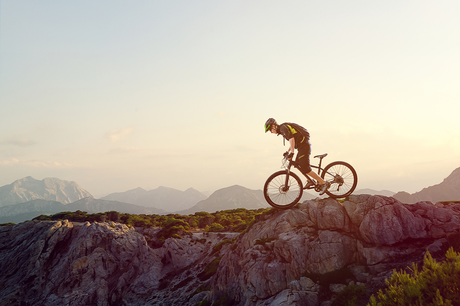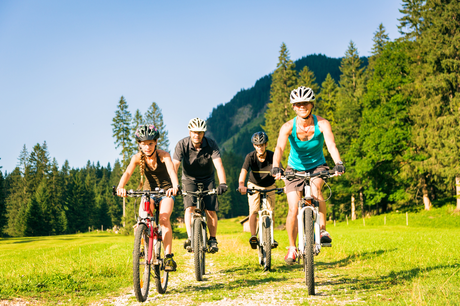Mountain biking is an amazing way to connect with nature, exercise, and have fun at the same time. It can be a way to challenge yourself or a great activity to enjoy with friends. Whatever your reason for riding is, in order to get the most out of the sport you need to be prepared with the right gear.
When you are a beginner it may seem overwhelming to pick out what will work best. Is it worth the money to spend a lot on clothing, or should you put a little more towards a better bike? Should you buy the new mountain-biking specific shoes that you love, or save the money and work with a pair you already have?
A lot of the gear depends on personal preference, but it can be hard to know your preferences when you are first starting out. Thankfully, mountain bikers love helping newbies break into the sport and are always willing to give advice on what works and what doesn’t.

The Right Bike
Buying your first mountain bike can be a daunting task. There are so many different bikes, mostly all with great reviews, so how do you pick? The first step is figuring out your budget.
If you want a new mountain bike with good suspension and support you will need to spend around $500-$1,000. Buying in this range will give you a great starter bike that you can rely on and feel comfortable riding for years.
Talking to someone at a bike shop can really help if you are struggling to decide…just don’t be afraid to ask questions! They are there to help you find a great bike that meets your needs.
Traveling with Your Bike
Buying the bike is exciting, but an often-overlooked part of mountain biking is how you are actually going to get your bike to the trails. If your vehicle is large enough, the easiest (and cheapest) way is to just make room. The front tire of your bike can be removed with minimal effort, and the bikes are light enough to easily load and unload.
If the bike won’t fit in your car, the next step is a bike rack. If you know you will be traveling a lot with your bike, it may be worth it to invest in some type of cross bar system or a hitch rack. If you do not want to spend a lot on a rack system, or you will be doing minimal traveling, trunk racks are easy to use and will get the job done.
Protect Your Head!
If you have experience biking, you may already own a helmet. For the first few rides most any helmet will be ok, but when you get on more intense trails you will need to switch to a mountain-bike specific helmet. These will be certified and they offer more protection for the back of your head in case of a crash.
Mountain biking helmets also have a visor to help block the sun which is helpful if you do not want to worry about sunglasses. Trails often switch between bright sun and dark trees so taking on and off your glasses can become a hindrance to your riding.
If you do wear sunglasses, make sure they are meant for outdoor activities. Regular glasses will fog up as you sweat and are hard to keep in place during fast riding.
What to Wear

Road cyclists often wear clothes that look like a second skin, however, mountain biking calls for a bit of a looser fit. You will still want something form-fitting; your clothes should be loose enough to absorb small hits from branches or gravel but not baggy enough to catch on trees or get caught in your bike chain.
Chamois shorts are loved by the biking community (especially women) because of their comfortable padding and great fits. They eliminate the need to wear underwear, which prevents chaffing from clothing that is not meant for biking. You can layer the shorts with a looser pair for extra protection if you are riding through a narrow trail or in cooler weather.
Make sure all of your clothes are moisture-wicking. Cotton or down clothing (even just socks) is a big no-no when it comes to mountain biking. If you are biking right, you are going to sweat. Probably a lot. If your material does not wick away the moisture, you will stay wet. Riding in wet clothes is not only heavy and uncomfortable, but it can cause rubbing and chaffing in spots you didn’t even know you had.
If you are riding in colder weather, make sure to layer your clothing appropriately. Wear items that are easy to remove once you start heating up but will keep you warm during the slower parts of your ride.
The Shoes
For beginners, pretty much any comfortable and close-toed athletic shoe will work. After a few rides you will want to switch to a shoe that is meant for mountain biking. These are generally wider than a normal athletic shoe and they have flat bottoms to help with traction on the pedals.
If you are going to be riding through trails with water or mud, waterproofing your shoes is a good idea. Pairing that with a good pair of waterproof athletic socks will make a huge difference in your riding comfort.
Gloves…Even in the Heat!
Riding gloves are extremely important to have when mountain biking, for beginners and for pros. Gripping the handles on your bike can be intense when riding through rough trails, causing blisters and calluses if you use your bare hands.
If you fall off your bike (and you probably will) gloves will protect your hands from rocks, sticks, and whatever else may happen to be down there.
Keep Your Whole Body Safe
When mountain biking you will most likely go through some rough terrain, leaving you will a decent chance of falling off your bike at some point. Especially when beginning, pads are an important part of giving yourself a safe ride.
Knee-pads are always a good idea, and depending on the type of riding you are doing, elbow and back pads can be helpful as well. Small, flexible pads are great for beginner riders because they are not bulky to wear, leaving you with your entire range of movement.
Backpack, Supplies, & Everything Else

If you are not prepared for your ride then mountain biking can turn into an awful experience within seconds. When riding enough miles, things are going to go wrong. At some point you will pop a tire, you will break a chain; maybe your shoe rips or your backpack strap breaks.
When going out into nature you need to be prepared for these things in order to save yourself potential hours of walking your bike back to the car.
Mountain biking is about becoming one with your bike, so that means a bulky backpack isn’t going to work very well. There are backpacks available that have adjustable straps and cinches which means if you do not fill the entire pack with supplies, you can still keep everything tight and secure. The most convenient ones also have a bladder slip with a drinking tube so you don’t have to worry about carrying a water bottle.
Filling the backpack depends on how long of a ride you are planning on taking; an overnight trip will call for a lot more supplies than you would need for a couple hours. There are a few general things you should have on you 100% of the time, no matter the length of your ride.
One of the most important would be a way to fix a flat tire. A tire pump is the easiest for beginners but some riders prefer a CO2 canister for a quick fill-up. You should always have an extra tire tube in case of a popped tire, and a cheap patch kit if something crazy happens and both tires end up flat.
Duct tape and zip-ties are good to have around, and they are both small and easy items to ride with. Always ride with a way to fix your bike chain; a multi-tool with a chain break on it is the easiest option. Also, don’t forget your phone, wallet, and a trail map (especially if you are unfamiliar with the area).
So, Basically…
There are a lot of options when it comes to mountain biking gear. There are no real answers on the ‘perfect gear’ because every person is a little bit different. It all boils down to riding in what makes you feel comfortable and keeps you safe.
If you are nervous about picking the right bike for your terrain, or the right clothes for the weather, talk to the community! Find people who mountain bike in your area and ask what works best for them.
If you are prepared for the elements and knowledgeable about the terrain you will have a great ride, and a great new sport.

